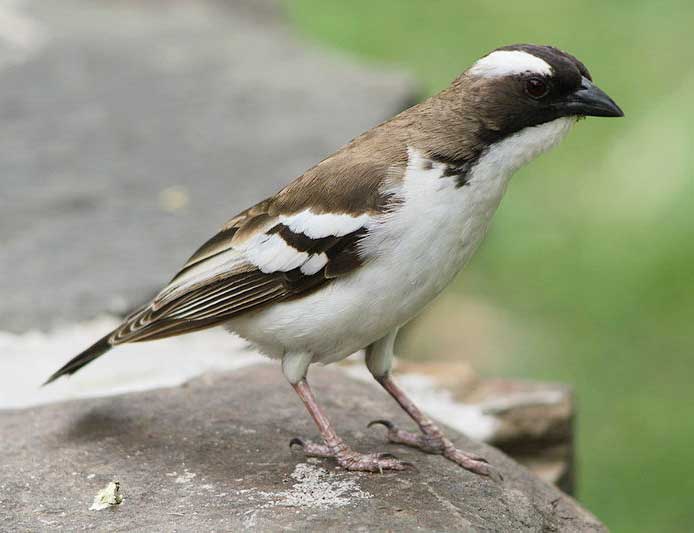Plocepasser mahali (*) Cladus: Eukaryota Name Plocepasser mahali A. Smith, 1836 Vernacular names Reference Report of the expedition for exploring central Africa p.51 The White-browed Sparrow-weaver (Plocepasser mahali; Afrikaans: Koringvoël) is a predominantly brown, sparrow-sized weaver found throughout central and northcentral southern Africa.[1] It is found in groups of two to eleven individuals consisting of one breeding pair and nonreproductive individuals. Taxonomy There are four recognized subspecies of the White-browed Sparrow-weaver. * P. m. mahali is found in the eastern part of the northern Cape Province of South Africa.
Voice The White-browed Sparrow-weaver may emit either a brief chik-chick or a loud, fluid, cheoop-preeoo-chop whistle.[2] Similar species The Yellow-throated Petronia has a pinkish brown (not black) bill, a buff (not white) eyebrow stripe, black (not pink) feet, and yellow shading at the bottom of a white throat. Additionally, the White-browed Sparrow-weaver is larger than the Yellow-throated Petronia. Unlike the White-browed Sparrow-weaver, the Yellow-throated Petronia may be found in broad-leaved woodland.[2] Distribution, habitat and migration The White-browed Sparrow-weaver is found in greatest numbers in north-central southern Africa. While this species most densely populates at dry regions with woodland or wooded grassland at northern South Africa, its range includes Botswana, northern and central Namibia, and western Zimbabwe. Populations may be found as far north as Ethiopia.[1] This species nests along thornveld and scrubby, dry riverbanks.[2] Because the White-browed Sparrow-weaver nests in colonies, populations are sedentary.[1] Reproduction Nesting Year round, groups of the White-browed Sparrow-weaver are active and nest-building. Groups of ten to sixty inverted-U-shaped nests of dry grass appear in the outside limbs of trees, although only several are used for breeding or roosting. While breeding nests have only one entrance, roosting nests have an entrance located at each of the two nest extremities. Research has shown that, throughout a region, nests are located at the leeward side of a tree. This behavior preserves a greater number of intact nests for breeding and roosting. White-browed Sparrow-weaver nests are sometimes used by other birds, such as the Red-headed Finch and Ashy Tit.[3] Breeding Breeding has been observed year round, but occurs mainly in warmer months.[1] Conservation status The White-browed Sparrow-weaver is becoming more abundant, expanding its range on southern, northern, and eastern fronts.[1] References 1. ^ a b c d e f Harrison, J. A.; D. G. Allan, V. Parker, C. J. Brown (1997) (PDF). The Atlas of South African Birds. BirdLife South Africa. pp. 532. http://web.uct.ac.za/depts/stats/adu/pdf/799.pdf. Source: Wikipedia, Wikispecies: All text is available under the terms of the GNU Free Documentation License |
|

